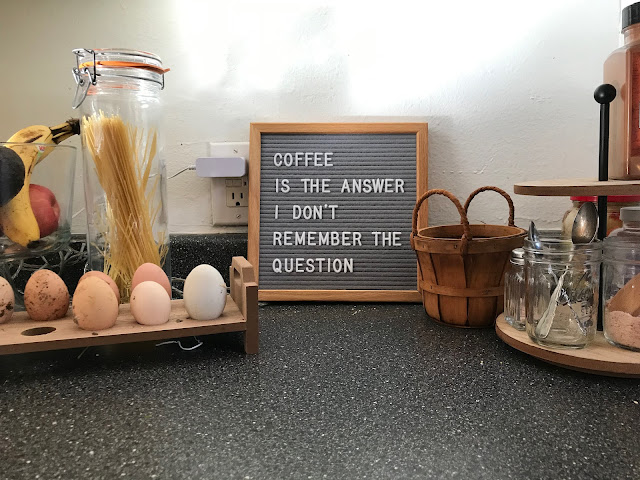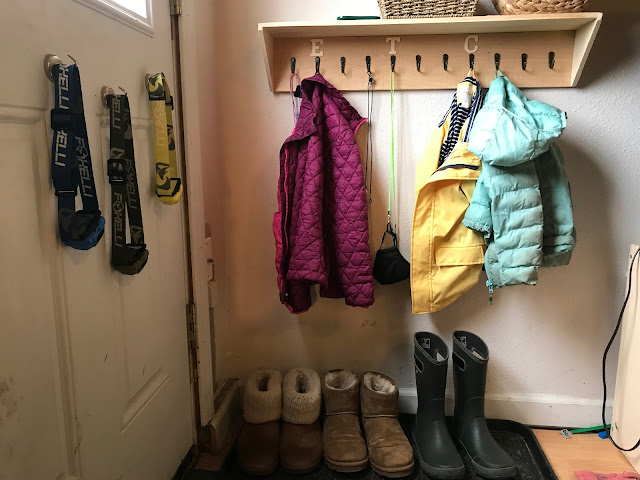I came across the principle of "close before you open" a couple of weeks ago and have been mulling over it since. The phrase was referring to the idea of finishing a project before starting another one, although I certainly think it works in the literal sense: some people are really good at closing cabinets before opening other ones (I, on the other hand, have open shelves in my kitchen so that I never have to do that). Many others tout the merits of "cleaning as you go" and I swear, every time I do that, I end up needing the thing I've thrown away and/or washed. I always, always have one more thing to chop if I wash the cutting board in the middle of cooking, even if I've tried to think ahead.
But, aside from the literal closing of things and how I can't be bothered (cf. House Guest Instructions on why there are so many open trash cans in our house), I also struggle with figurative closing. I excel at starting--or generating--new projects, but find myself often abandoning projects once the novelty has worn off.
This has been a characteristic of mine since childhood. I wondered if it might be a maturity thing, but I've come to suspect that it's an inherent trait of mine.
I lose interest once the hard parts are done and find completion boring. I love to come up with systems, and then am guaranteed to abandon them as soon as tehy start working because now it's boring.
This came as a surprise to Diana when I mentioned it yesterday, as she sees me enjoy being a "closer" for others. This is because I get the gratification of their praise or affirmation. But no one praises me when I do a good job on my own things.
BTW if you've ever wondered why it's easier to do someone else's dishes than your own, it's because of this, the Frog-and-Toad-raking-each-other's-leaves-story Principle.*
(*Another universal principle: Kids ALWAYS want a banana if they see it in someone else's home, but NEVER wants to eat it at their home.**
**EMALES: Do you remember when the cashier at Trader Joe's asked me if I lived in a zoo?)
Anyhoo, I've been trying to figure out how to encourage both: the generation of ideas and the execution of ideas, all while also completing the many boring, yet necessary, tasks of life.
In the gap is where I have to let some darlings go. And while I recognize that some culling needs to happen, I don't need to go so far as to never capture all the ideas in the first place.
Since becoming a follower of David Allen in 2008, I have pretty much limited myself to only capturing ideas in one main place, my "Moleskine GTD" (shout-out Momiller!). It's been my saving grace for capturing ideas and todos.
This post isn't about GTD, but as a brief summary, Allen's philosophy is that your brain isn't meant for storage; it's meant ideation. The less you force your brain to remember, the more room it has for creativity, problem solving etc. Thus, he urges readers to get their thoughts down externally, whether through digital or analog means.
For over a decade I have consistently kept up with a Moleskine journal in which I've kept my "Inbox," "Someday/Maybe," and "Notes" sections. (It's evolved a little bit into a bullet journal, but it still has the heart of the OG Moleskine Hack, which I can't even find on the internet anymore because it was in 2007.)
I can't remember if Allen explicitly preaches against Post-it notes, but I've often heard that "naturally disorganized" people should avoid Post-it notes because they're not conducive to containing your junk. (Remind me to write a love letter to the Post-It note soon. I think I wrote a Post-it note already to do this, but just in case.)
However, when I read Jacyln Paul's book Order From Chaos this past January, I learned that while it's important for people like me to minimize the number of physical and digital inboxes that need to be processed, I need to maximize the number of places I can capture thoughts (what Paul calls "thought containers"). Enter: the Post-it note. (Other options are white boards, chalk boards, smart phone apps, etc.)
In the last month and a half, as an experiment, I've opened the floodgates of Post-it note usage without shame or fear. (Don't freak out, Molly. I haven't abandoned the Moleskine; this is in addition to that system.) I have stacks of them everywhere in the house so that most of my myriad thoughts can land (and stick!). It has reduced my anxiety to know that my musings won't get lost.
(We don't have a huge house, but my brain does forget what it was doing if I have to leave a room to find a pad of Post-its.)
But, as you're probably wondering and I had wondered, what do I do with them and how do I not get overwhelmed by the sheer number of them?
Thankfully, Paul explains this in her book, primarily drawing from Allen's principles. The most helpful aspect was the concept of "Context," which she explained in a way that really stuck with me. She actually contextualized the idea of contextualizing for the ADHD brain. She helps us ask what tool, location, or situation is needed to complete the task. Some example contexts from her life are: "House (anytime), House (while my son's asleep), House (while my son's awake)... Outdoors...Weekend...Craft room...Computer...Phone (talking) and Phone (texting)...Television, for things I can do in front of the TV" (143-144).
As I'm experimenting with amending a system I have kept for 14 years (that is stinking long, especially considering I can't usual stick with systems after they start working), I've come up with a three-step summary of what I learned from Paul's book on how to manage my idea flow. And because I love you guys, they all start with Cs.
1) Capture: This is the permission to capture all my thoughts. So what if experts say to use one central list vs. millions of yellow sticky notes? It's more important for me to reduce anxiety that I'm not forgetting something. I'm still using my bullet journal as my main spot; Post-its are just a portable extension of that system. But, I don't stop there with just writing it down; the next step is to contain.
2) Contain: I'm currently in the process of limiting the number of actual inboxes where I process this information. (Another time we can get into why my baseline is to have lots of piles, and how prior to this point, I didn't think they deserved the dignity of being called inboxes.) The main one is on my desk in our room, and there's another one in the kitchen. At my desk, Post-its go in a physical inbox under a piece of fabric (so I don't get distracted by them, but I know they are there, and they are safe, resting under a pillowcase).
(Incidentally other non-Post-it note items also go in these inboxes: stuff I have to deal with that is important but not urgent and requires a different kind of brain than I normally like to use.)
I now feel a new kind of freedom (rather than guilt) about capturing and containing all these things (flat and sometimes three dimensional), because I know I have set aside time each week to address each item and contextualize it.
3) Contextualize: This is the (currently once-a-week) processing step of All. The. Stuff. I prepare the following supplies to tackle these piles: a hot beverage, my aforementioned GTD notebook, my physical project files, and my computer.
What I mean by contextualization is that I'm taking this time to figure out where the information or item will be relevant, if at all. Is it an email I need to send, so I put it by computer? Is it a blog idea, so I put it in my folder for blog ideas, or a home organizing idea so I put it in folder for the relevant room? Is it something my kids asked me to do? Is it an item I wanted to give someone so now I need to contact them to see if they want it? Where do I need the note to be so I can take appropriate action on it? Or, if the item or note has lost its relevance by the time I get around to it, it's time to discard or recycle.
It seems to be working so far because it utilizes the batching strategy: doing thinking/processing all at once, and not in between (or in the middle of) thought generation.
I've been doing this for almost a month and I think it's working. I'm maybe creating more work for myself, but I think that's just how I roll.*
(*Apparently, Theo inherited this trait from me. He is constantly doing more work to get out of doing work. E.g., building a LEGO conveyor belt that has to be manually wound in order to throw small pieces of trash away into a trash can below.)
--
Okay, that was a lot of words about Post-it notes, ideas, GTD. Thanks for bearing with me. I think it's important that I write this here because one of my biggest takeaways from Order from Chaos that will be a gift for me if I can remember it is this: I need systems that are robust enough to handle the way I think, but simple enough that I can do it for the rest of my life. If I don't keep up with idea-and-stuff management, I will be worn down by the nagging feeling of forgetting something, the demoralizing feeling of not finishing projects I start (and/or being surrounded by clutter), and the concern that something important is being neglected.
Thanks for reading this!









